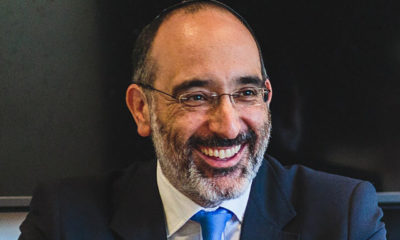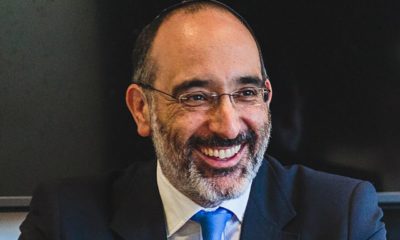
Lifestyle/Community
“Community has a spring in its step” – Chief
ANT KATZ
Whereas around 10 000 among SA Jewry normally observe Shabbos fully, pundits put the figure for 11/12 October’s Shabbos at at least 30,000! The almost unbelievable success of The Shabbos Project is no secret, it has become an urban legend among SA Jewry.
But the level of its success, both in SA and among global Jewry, is an even more amazing story. As are Rabbi Goldstein’s thoughts on just why this idea exploded and the ramifications going forward.
“I am by nature an optimist,” Rabbi Goldstein says, “but the breadth and depth of the support and participation caught me off guard. The response has been overwhelming!” One of the things he liked most, says The Chief, was the way SA Jewry “proudly celebrated who we are.” That’s the SA culture, he says, unity in diversity.
The measures of success and involvement, says the Chief Rabbi, is based on anecdotal evidence – of which there is much to find. He believes that “the majority of the community” participated in some way.
“People had a chance to experience for themselves the inspiring and refreshing energy of Shabbos,” he says, but it was also about bringing families together and the kind of community building energy it generated. Shabbos, says the Chief, brings beauty into our lives. He quotes Justice Brandeis: “Stealing a day out of life to live.”
Another aspect that amazed Rabbi Goldstein, he says, “was that there was a true sense of joy and celebration – like the thousands who joined the chala bake and the 600 who turned out for the street dinner in Oaklands. There was a – tremendous atmosphere of taking to the streets.”
The Chief Rabbi says that the community response has also “captured world Jewry. I think we can feel a great sense of encouragement in our amazing, amazing community.”
What sparked the idea of The Shabbos Project?
A secular Israeli working in Israel, Prof Dan Ariely, was in SA last year on a consulting project. The Chief says he is one of the most respected behavioural scientists in the world. While in SA he made contact with Rabbi Goldstein as he was looking to find answers about Judaism. “We spoke about Shabbat and that was where the germ of the idea came from,” says the Chief Rabbi. “I stayed in contact with him.”
Ariely ended up keeping Shabbat last weekend for the first time. He also drafted a survey and has been researching what he considers to be the amazing social phenomenon in The Shabbos Project.
What garnered this success?
What does Rabbi Goldstein attribute the overwhelming success of this project to? “It hit the sweet spot,” he says, “both the breadth and the depth of the support was unbelievable.”
He says that two weeks prior to the event, “it passed the tipping point.” From then on in, it was the talk of the community, momentum started to mount and the excitement became palpable. –
The team that had been so successful on the Sinai Indaba and Generation Sinai projects were mustered into service. In fact, the team has been kept on for an extra month “to deal with the unanticipated mass of data from a quantitative and qualitative point of view,” says the Chief.
“The ultimate goal of this was to say: ‘Shabbos belongs to every Jew’ and people responded to this – they reconnected with an Old Friend, Shabbos,” says Rabbi Goldstein. He says that the invitation to participate went to all of SA Jewry, including Progressive and unaffiliated Jews – who, by all account, also embraced the event.
Rabbi Goldstein started formulating a plan with Laurence Horwitz. “I unveiled it at the closing session of the Sinai Indaba.” He says “and then we started fleshing it out.” He wrote an eight-point manifesto, met with Rabbis and briefed them at Rabbinical Conference, brainstormed with the Rabbis, met with the schools, primarily KDS and Herzlia and later met with Shul lay-leadership at the UOS conference .
“We brainstormed how to involve the schools so they all owned it,” he explains. Prefects of some schools became Project Ambassadors, Shuls and schools were partners. Our shuls were the most amazing partners and really made The Shabbos Project come alive for people. “That was crucial in attaining the tipping point and moving into high gear,” says the Chief Rabbi.
He then transferred ownership to Jewish institutions and individuals. “When people are invited to an event they go as a passive passenger,” he says, “this created active partners, even leaders – and led to spontaneous positive energy.”
“I have heard stories of people who went knocking on doors and inviting strangers to Shabbos, taking it from awareness to participation.” It had achieved that spontaneous energy.
“Community has a spring in its step”
With The Shabbos Project, says Rabbi Goldstein, “the community has a spring in its step!” He feels that Shabbos offers a compelling message for modern times, it comes with a message of rejuvenation, of family connection, and people have been stopping him in the streets to tell him that this was what they experienced.
“There have been a flood of sms-s and e-mails, wherever I go people are stopping me, stories are coming in from people who go to Shul once or twice a year – and they walked to Shul!”
Rabbi Goldstein’s wife, Gina, authored The Shabbos Project Guide Book which explained how to keep Shabbos for those who had never done so before.
The Chief admitted it wasn’t always easy, “there were voices of scepticism saying we should dilute it,” – meaning not push for people to keep Shabbos entirely. “I wanted to give it the authenticity. Why aim for less before you’ve even started?” he says.
Measures of success
The anecdotal evidence of the success of The Shabbos Project is overwhelming. It’s become a social movement.
Rabbi Goldstein points to the fact that Shuls were packed as if it was Rosh Hashanah, and at some with not a cars in sight. At Houghton Golf Course caddies went home. The non-Jewish Bridge Association posted under half of their normal scores. A non-Jewish-owned hairdresser closed on Saturday. A soccer coach cancelled training.
The stories keep pouring in of people who kept their first Shabbos – and it has morphed into “This is My Story” which can be seen (or added to) on the project’s Facebook page and Youtube channel. Testimonials can be sent to office@chiefrabbi.co.za or posted to https://www.facebook.com/theshabbosproject
The Shabbos Project has gone global
While the Chief’s “Generation Sinai” project went to more than 100 schools in 38 cities worldwide – The Shabbos Project has been an even bigger hit. It is now planned as an annual event in SA.
In Venice, Italy there was a Chala Bake in solidarity with the Project. “We are inundated with formal expressions of interest” says Rabbi Goldstein, fromthe US, Canada, Israel and Australia based on the SA experience, and “It has captured the (Jewish) world’s imagination,” he said this week. “There is a thirst out there in being able to give an authentic Jewish experience.”
The Chief Rabbi says that he and his team are working on an operational model so that as many communities around the world can share in the magic of The Shabbos Project. He foresees this as a “great South African export.”
“People are asking me: ‘Now what?,” says Rabbi Goldstein. “The place for this to be taken further is in our shuls and homes.” Individuals and families and communities are working out their way forward.
Clearly pleased with the results, and so he should be, Rabbi Goldstein says humbly: “We worked on this together, as a community, people rose to the occasion.” That may well be true, but it took an inspirational leader and a masterful executive to make it happen.










